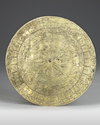A PERSIAN ASTROLOGICAL DISK, ILM AL-RAML, 18TH CENTURY
A Persia engraved astrological disk, cast and engraved bronze, depicting the twelve zodiac signs, magic squares, and the dot and lined figures created using the ilm al raml technique (‘the science of the sand’).
The art of using dice for fortune-telling was developed at least 4000 years ago, long before dice were first used to play games. The origin of the distinctly Islamic art of geomancy is uncertain, but it appears to have been well established in North Africa, Egypt and Syria by the 12th century. Unlike astrology, geomancy did not require astronomical observations and calculations. Instead, divination was accomplished by forming and then interpreting a design, called a geomantic tableau, consisting of 16 positions, each occupied by a geomantic ‘figure’.
A similar lot at Victoria and Albert Museum number: 505-1888 and 505 A and B – 1888.



